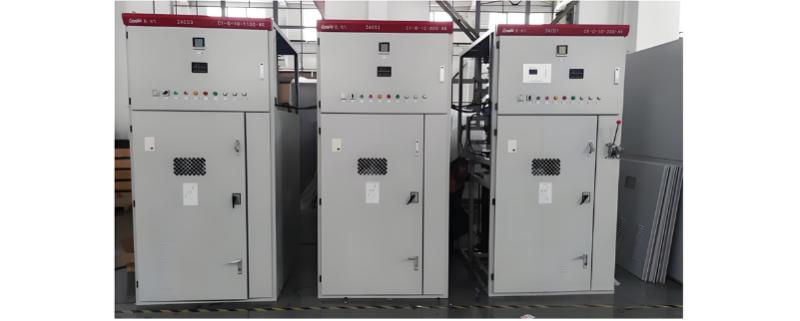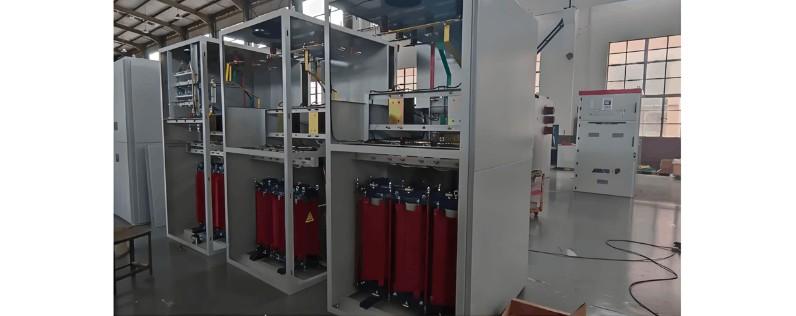10kV ultrasîfî bêkarîna bêkarî ya reaktîvî û bêtikrîbarî ye di serbazên bêkarîya modern de. Bi pêşkeftina an destkirina bêkarîya reaktîvî, ên çareseriya meselean wekî kuastî bêkarîya sîfî, zêdetirîna herîna rasteyan û degelîna dana ji xwe bihêva tevabûna bêkarîya reaktîvî, yekîni rola naveroka li ser piştgiriya ekonomî, ewlehiyayetî û kalîta bêkarîya serbaz. Bêkarîna bêtikrîbarî reaktîvî 10kV yekîni amara naverok e li ser piştgiriya serbazêkî û ekonomî.
Têne qeyb bike wergeriya çalakîyê ye têne bikar bibe ji bo parzûng, heta li gor kirina pelana parzûngî cih di navbera testkirina pêşrefî û şopandina rewşa - da malpera herî hilbijareyê ye têne gihîştin ji bo piştgiriyekirina xebatî. Karên parzûng hewce ne di navbera karkerên malper û biboxan hatine bicîh bikin di navbera rêzikî yên destnîşîn. Ji ber vê, heye şerazî tekmîl u derbasdar di navbera alîkarên wekheviyê û biboxan. Ji ber vê, li jêr heye şerazî tekmîl u derbasdar di navbera alîkarên wekheviyê û biboxan di navbera alîkarên wekheviyê û biboxan.
1. Wergeriya Çalakîyê ya Bêkarîna Bêtikrîbarî Reaktîvî 10kV
Mihenda Mînaka: Pirsgirêka karîba sîfî serbazê, zêdetirîna herîna rasteyan, stabîl kirina dana sisteman û pêşkeftina kalîta bêkarîya pêşkeftina.
1.1 Wergeriya Rastkirina
Çavkaniya Bêkarîya Reaktîvî: Baranên indûktîvî (wêje, transformatoran) di serbaz de dibînin guherandina meysena, ku bêkarîya reaktîvî (Q) dikarin.
Rêbaza Rastkirina: Bankên kapasitordan bi paralel têne girîng, ku bêkarîya reaktîvî kapasîtî (Qc) dide ku bêkarîya reaktîvî (Ql) digere.
Rewşa: Bêkarîya reaktîvî (Q) ku serbaz dixwaze, bêkarîya sîfî (Cosφ = P / S) pêşkeftin, û bêkarîya derbas (S) dikarin.
1.2 Anajînên Amara Rastkirina
Banka Kapasitora Bêtikrîbarîya Ultrasîfî: Anajîna mînaka ku bêkarîya reaktîvî kapasîtî dide. Her du kapasitordan bi seri û paralel têne girîng da ku bihêve 10kV û behtariyên derbas îmkanî.
Reaktor Seri:
Reaktor Cûhdaran: Cûhdaran di dema kapasitoran têne girîng (herêmî 5-20 ji herêmî derbas), kapasitoran û alîkarên têne girîng.
Reaktor Parzûn: Bi kapasitor (herêmî bi herêmî 5, 7, an herêmî derbasî) têne girîng, ku bêkarîya herêmî bihêve kapasitor, û bêkarîya herêmî bihêve kapasitor, û bêkarîya herêmî bihêve kapasitor, û bêkarîya herêmî bihêve kapasitor.
Alîkarên Bêtikrîbarîya Ultrasîfî:
Kontaktora Vakûm an Karkera Vakûm: Bi têne girîng bankên kapasitoran. Kontaktoran vakûm zêde bikar hin da ku bi serdibêjî têne bikin.
Alîkarên Serdibêjî / Alîkarên Zarav: Di dema parzûng de bihêve serdibêjîya nîşang û bihêve zarav.
Amara Discharge:
Alîkarên Parzûn:
Fuse: Parzûn di navbera kapasitoran de bihêve serdibêjî (fuse).
Parzûn Relaya: Herêmî parzûn (serdibêjî serdibêjî), unbalance (sardibêjî serdibêjî kapasitor an fuse), overvoltage, undervoltage, harmonic overlimit, open-delta voltage, etc.
Alîkarên Pêşdestkirina û Kontrol:
Controller: Pêşdestker bihêve dana, current, bêkarîya sîfî, harmonic current, harmonic voltage distortion rate, û parametreyên din. Têne kontrol bihêve kapasitoran bihêve strategî (e.g., target power factor, target voltage, harmonic over-limit protection, time-based programs).
Current Transformer (CT), Voltage Transformer (PT): Nîşan bihêve pêşdestkirina û parzûn.

1.3 Rewşa Çalakî
Şopandina: Controller bihêve şopandina parametreyên wekî bêkarîya sîfî, dana, û bêkarîya reaktîvî.
Dawetin: Ji kerema xwe controller bihêve command.
Energizing: Circuit control bihêve kontaktora vakûm têne girîng, kapasitor bank (herêmî bihêve reaktor seri) têne girîng bihêve busbar 10kV.
Rastkirina: Banka kapasitoran bihêve bêkarîya reaktîvî kapasîtî, digere bêkarîya reaktîvî, bêkarîya sîfî, û dan.
De-energizing: Ji kerema xwe controller bihêve command, kontaktora vakûm têne serdibêjî, û banka kapasitor têne serdibêjî.
Discharge: Pas di dema ku banka kapasitor têne serdibêjî, device (coil) bihêve discharge, têne bihêve energy.
2. Parzûng û Parzûn 10kV Bêtikrîbarî Bêkarîya Reaktîvî
Mihenda Mînaka: Piştgiriyekirina xebatî, ewlehiyayetî û efektî, û dilindana wextê.
2.1 Şopandina Roja
Şopandina Nîşan: Şopandina kapasitor casing, oil leakage, rust, paint peeling; şopandina bushings, cracks, contamination, flashover traces; şopandina connection points, looseness, overheating, discoloration.
Sound Operating: Listen for abnormal vibration or noise from reactors, discharge coils, or capacitors.
Instrument Indication: Check if the indications of voltmeters, ammeters, power factor meters, and reactive power meters are normal, and compare with the controller display values.
Environmental Check: Check indoor ventilation, ambient temperature, and humidity to ensure they are within allowable limits; check for dust accumulation or signs of small animal intrusion; check if fences and labels are intact.
Protection Signals: Check if there are any alarm or trip signals from the protection devices.
2.2 Periodic Maintenance (Typically Every Six Months to One Year)
Power-Down Cleaning: Thoroughly remove dust and dirt from the surfaces of capacitor casings, bushings, insulators, busbars, frames, reactors, and switchgear (using dry, lint-free cloths or special tools, avoiding insulation damage). (Important! Cleaning of high-voltage equipment must be done after power-off, voltage testing, and grounding!)
Tightening Connections: Check and tighten all electrical connection bolts (busbar connections, capacitor terminal connections, grounding wires, etc.) to ensure good contact and prevent overheating. Operate according to specified torque.
Capacitor Testing:
Capacitance Measurement: Use a dedicated capacitance bridge to measure the total capacitance of each phase or each branch (if applicable), and compare with nameplate values or historical data. If deviation exceeds ±5% or shows significant change (especially decrease), it requires close attention, possibly indicating internal component damage. The capacitance value of a single capacitor should not deviate from the rated value by more than -5% to +10%.
Insulation Resistance Test: Measure the insulation resistance between poles and between pole and case (using a 2500V megohmmeter), which should meet regulatory requirements (typically, inter-pole insulation resistance should be very high, pole-to-case insulation resistance > 1000MΩ). Must be fully discharged before and after testing!
Dissipation Factor (tanδ) Measurement: Can be performed if conditions allow, which is more sensitive in reflecting internal capacitor insulation moisture or deterioration. Should not show significant increase compared to factory or previous measurement values.
Reactor Inspection:
Check coil appearance for overheating, discoloration, insulation aging, or damage.
Check if core (if present) fasteners are loose.
Measure winding DC resistance, which should not show significant difference compared to factory or previous values (considering temperature influence).
Measure insulation resistance.
Discharge Device Check:
Check discharge coil appearance and wiring.
Verify discharge performance (under safety regulation permission, simulate operation to verify residual voltage drop speed).
Switching Equipment Maintenance:
Check vacuum interrupter appearance.
Check if operating mechanism operates flexibly and reliably; apply appropriate lubricant to lubrication points.
Measure main circuit contact resistance.
Perform mechanical characteristic tests (opening/closing time, synchronism, bounce, stroke, etc.).
Protection Device Calibration: Calibrate settings and perform transmission tests for overcurrent, unbalance, overvoltage, undervoltage, etc., according to regulations to ensure accurate and reliable operation. Check fuse appearance and indicator status.
Controller Check: Check if display, buttons, and communication are normal; verify sampling accuracy (compare voltage, current, power factor, etc., with standard meter); check if switching logic is correct.

2.3 Special Maintenance
Harmonic Environment: If the system has serious harmonics, strengthen monitoring of temperature rise of capacitors and reactors (infrared thermography), conduct regular harmonic tests, ensure tuning point settings are reasonable to avoid resonance. Add filtering devices if necessary.
Frequent Switching: Strengthen inspection of contact wear of vacuum contactors/circuit breakers, shorten their maintenance cycle.
After Faults: After protection operation (especially fuse blowout or unbalance protection operation), the cause must be thoroughly identified, damaged components replaced, and comprehensive inspection and testing completed before re-energization.
2.4 Safety Precautions (Most Important!)
Strictly enforce the "Two Tickets and Three Systems": Work Ticket, Operation Ticket; Shift Handover System, Patrol Inspection System, Equipment Periodic Testing and Rotation System.
Power-Off, Voltage Test, Grounding: Before any maintenance work, the power source must be reliably disconnected (including possible back-feeding from PT secondary side), use a qualified voltage tester to confirm absence of voltage, and install grounding wires at both ends of the work location. The capacitor bank must be fully discharged using a dedicated grounding rod and grounded before contact!
Dedicated Supervisor: Operation and maintenance of high-voltage equipment must have a dedicated supervisor.
Use Qualified Tools and Protection: Use tools with qualified insulation rating, wear insulating gloves, insulating boots, and other safety protective equipment.
Residual Voltage Awareness: Even after discharge, use a grounding rod to short-circuit capacitor terminals again before contact.
2.5 Record Keeping and Analysis
Record data from each inspection, maintenance, and test in detail (capacitance value, insulation resistance, temperature, protection action information, etc.).
Establish equipment files, perform trend analysis, and promptly identify potential defects.
Record abnormal conditions and handling processes.
3. Reference for Key Maintenance Intervals
Daily Inspection: Daily or weekly (depending on importance and operating environment).
Periodic Cleaning and Inspection (without power-off): Monthly or quarterly.
Periodic Maintenance (with power-off): Once to twice a year (combined with preventive testing).
Capacitor Capacitance/Insulation Resistance Measurement: Conducted during power-off maintenance; once within one year of commissioning, then once every 1–2 years.
Protection Device Calibration: Once a year.
Switching Equipment Characteristic Test: Combined with power-off maintenance, once every 1–2 years or when operation count reaches a certain value.
4. Notes
Ambient Temperature: The operating ambient temperature of capacitors must not exceed the specified upper limit (typically -40°C ~ +45°C), avoid direct sunlight.
Overvoltage: Capacitors can operate long-term at 1.1 times the rated voltage; avoid prolonged overvoltage operation.
Overcurrent: Capacitors can operate long-term at 1.3 times the rated current (considering harmonic and overvoltage effects).
Harmonics: Harmonics are one of the main causes of capacitor damage. The system harmonic background must be considered during design, and the reactor ratio configured reasonably. Strengthen harmonic monitoring during operation.
























